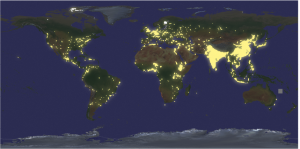Individual Efforts:
Bryce: Learned how to animate with lerp in Unity, and learned about agents and npc scripting. Cleaned up assets for elevator entry scene and began to model it with different lighting and shaders. Experimented with reflection probes and custom materials.
Liang: Wrote a draft of the plot, trying to bridge the visualization with narrative. Searched for resources on how to communicate scientific topics to a general audience. Compiled research on energy, genetically modified food, and pollution.
Trevor: Set up some data in GIS and created a few test visualizations (below). Found reliable sources for data on topography, pollution, deforestation, and population. Learned about texture mapping in Unity and played around with tutorials for the software.
Accomplishments:
Started our visual storyboard. We have some presentations on science communication to reference. We continue to grow out information about the environmental topics we want to communicate. We have rough draft scenes for both the elevator entry and the space view. Learned how basic animation works in Unity. Found reliable global data for all of the environmental effects we will visualize.
Possible population representation, made with ArcGIS and Illustrator:
Possible deforestation representation, made with Photoshop:
Problems:
We’ve realized that the story we use for the VR will be very dependent on the level of interaction the users have. Thus we’ve decided to focus on the key concepts that we want to teach the users instead of the narrative that surrounds it. Once we have those facts and interactions, we can then focus back on the narrative and we may build the story around that.
Global data is obviously a large-scale process, and regular computers can’t handle it on the scale we need. We may need to save the more intricate mapping visualizations for supplemental screens on the side instead of for the actual globe in our VR model.
There needs to be a visual storyboard developed. We don’t really know what our project might look like in VR due to using the CAVE, can we use it? Timing is an issue that is becoming apparent, we need to consider how long interactions and visualizations may take.
For next week:
- Continue modeling environments
- Continue creating data visualizations
- Visual storyboard completion
- Scientific communication:
- What information we want to teach the users
- Key talking points in these categories
- Agriculture usage
- Projected population/growth rates
- Deforestation
- Pollution
- Effective ways of informing public about scientific concepts and ideas
